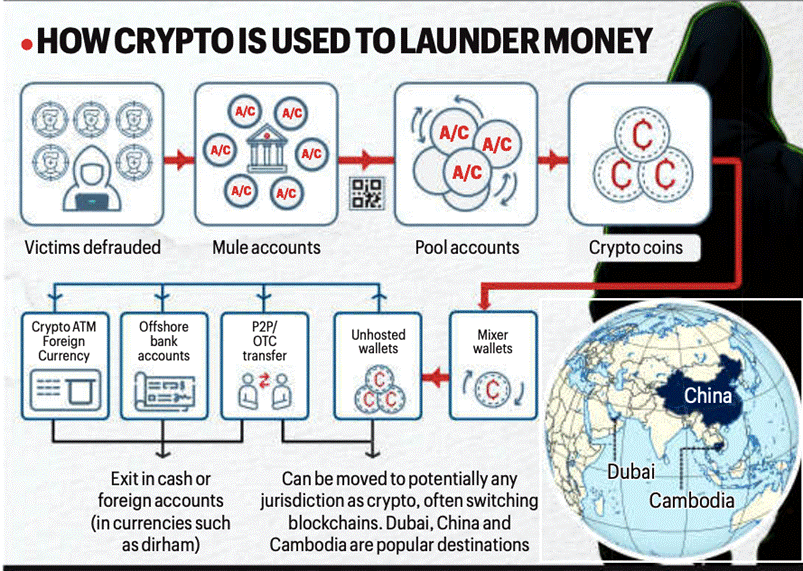Why in News?
- An international investigation by The Indian Express + International Consortium of Investigative Journalists (ICIJ) + The Coin Laundry Project exposed how cryptocurrency is emerging as the new hub for cross-border money laundering, replacing traditional tax havens.
- Agencies tracked laundering routes from India → Dubai → China → Cambodia via crypto exchanges and OTC brokers.
- The report highlights misuse of mule accounts, fake wallets, P2P transfers, and unregulated crypto channels for hawala-style transactions.
Relevance :
GS 3 – Economy & Security
- Money laundering through crypto; hawala 2.0.
- PMLA applicability to crypto; FIU, ED roles.
- Financial fraud ecosystems (Cambodia scam hubs, Chinese networks).
- FATF, AML/CFT regulations, global crypto governance.
GS 2 – Governance
- Cybercrime regulation gaps; need for global crypto rulebook.
- Issues with KYC, consent, anonymity.
GS 3 – Internal Security
- Crypto in sextortion, betting, cybercrime, loan apps.
- Cross-border criminal networks.

What is Crypto Money Laundering?
- Using digital assets (BTC, USDT, ETH) to obscure origins of illicit funds.
- Operates through anonymous wallets, mixers/tumblers, P2P platforms, decentralised exchanges (DEXs).
- Mimics old hawala, but:
- Faster
- Harder to trace
- Borderless
- Uses technology to hide audit trails
How Cryptocurrency Is Used to Launder Money (as per investigation)
- Victims defrauded → money deposited in mule bank accounts.
- Funds routed to pool accounts controlled by operators.
- Operators use:
- Crypto OTC desks
- P2P transfers
- Unhosted wallets
- International crypto exchanges
- Crypto moved to Dubai / Cambodia / China → cashed out into local currency → returned as “clean” funds.
- Mimics classic hawala but using USDT (Tether) as preferred stablecoin due to near-zero volatility.
Key Findings from The Coin Laundry Project
- Over $12 billion globally laundered via crypto-linked fraud networks (ICIJ estimate).
- India emerging as a major node for:
- Pig-butchering scams
- Crypto-based forex arbitrage
- Investment fraud networks
- Crypto transactions used to layer money across borders without physical movement.
- Migrant workers, students, and gullible individuals used as mule account operators.
- Several crypto exchanges in India flagged for weak KYC, fake identities, and lax monitoring.
Why Crypto is Attractive for Criminal Networks
- No central authority, decentralised validation.
- Pseudo-anonymity: wallet addresses not linked to verified identities.
- Micro-transactions allow easy structuring.
- Instant transfer across borders with minimal cost.
- Difficulty for agencies to track mixers, privacy coins, TOR + VPN used transactions.
Case Studies Mentioned
- Multiple Indian firms and individuals allegedly routed money through USDT to China-based operators.
- Fraud rings in Jharkhand, Maharashtra, Telangana using cryptocurrency to bypass hawala raids.
- Several accounts flagged for₹1,000 crore+ cyber fraud ecosystem connected to Cambodia scam factories.
Agencies’ Findings (ED, FIU, State Police)
- Crypto part of layering in cybercrime, betting rackets, sextortion, loan apps.
- ED & FIU identified routes:
- India → Dubai (crypto OTC desks)
- Dubai → China (USDT wallets)
- China → Cambodia scam hubs
- P2P crypto traders act as parallel hawala operators.
- FIU issued notices to several exchanges for AML violations.
Regulatory Issues in India
- Crypto is not illegal but unregulated.
- AML provisions extended under PMLA (2023) but enforcement weak due to:
- No licensing framework
- Unhosted wallets outside Indian jurisdiction
- Difficulty tracing foreign exchanges
- India proposed global crypto regulatory framework at G20 (2023) but progress slow.
Implications for India
- Cybercrime escalation: online scams use crypto for instant international payouts.
- Economic risks: capital flight via unregulated crypto pathways.
- Internal security challenge: scam operations in Cambodia/Myanmar targeting Indians.
- Threat to banking integrity: mule accounts becoming systemic.
- Diplomatic/consular challenges: rescuing Indians trapped in foreign cyber-scam factories.
Global Context
- FATF identifies crypto as a major ML/TF threat.
- Countries like US, EU, Singapore tightening rules on:
- KYC for exchanges
- Travel Rule
- Mixer/service provider licensing
- Rise of privacy coins (Monero, Zcash) complicates global enforcement.
Way Forward
- Implement comprehensive crypto regulation covering exchanges, wallets, stablecoins.
- Full FATF Travel Rule compliance for Indian exchanges.
- Mandatory KYC + PAN integration for large crypto transfers.
- Licensing regime for OTC desks.
- Strengthen FIU, ED digital forensic tools for tracing blockchain trails.
- India must push for global cooperation on unregulated exchanges and scam hubs.



